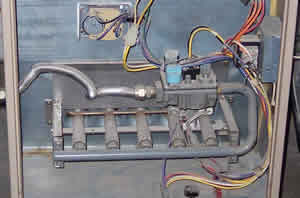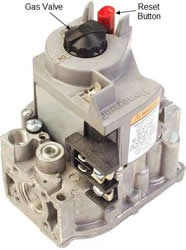If your furnace uses a pilot flame, referred to as a standing pilot, in order to light the gas in the burners, you may have faced the problem that it has gone out and hence your furnace won’t operate.

Figure 1 - Burner area of a gas furnace
The pilot light runs all the time, but it can go out for numerous reasons. The most common being a disruption in the gas flowing to your home.
Modern furnaces are designed without a standing pilot light, they use electronic ignition to ignite the gas, which is much more economical as the modern gas furnace only consumes gas when it is heating your home.
Note: Universal electronic ignition systems can be purchased and retrofitted to replace old style standing flame systems.
If you find that your furnace is not producing heat, you should check:
- The circuit breaker or fuse that powers the furnace.
- The thermostat, making sure that its settings are correct for requesting heat.
If both of those items are operational, you should check your pilot light.
As previously mentioned the pilot light operates all the time and the gas furnace has a device to verify that the pilot light is lit. The device used is called a thermocouple. The thermocouple generates a small electrical voltage when it is hot. This electrical voltage is then used to open the gas valve to allow gas to flow to the burners. When gas begins to flow to the burners, it is ignited by the pilot light.
If the pilot light is not lit or not functioning properly, the pilot lights flame is not hot enough to ignite the gas, then the gas valve is not allowed to open even if the thermostat is calling for more heat in your home.
Note: The thermocouple is a failsafe device. If the thermocouple is not operating properly the gas valve will remain in the "OFF" position, even if the pilot light is functioning properly.

Figure 2 - Gas furnace control valve
Lighting The Pilot Light:
Note: Most gas furnaces will have instructions for lighting the pilot light on the inside of the burner door cover or on the inside sidewall of the gas furnace. The furnace instruction manual (I know you can’t find it!) will also have the instructions for lighting the pilot light.
Step 1:
Set the furnace’s thermostat (the same thermostat that controls the heat level in your home) so that it will request the furnace to supply heat.
Step 2:
Remove the burner door. Do a general visual inspection of the components, looking for any obvious damages.
Step 3:
Locate the gas valve control. There are numerous styles of gas control valves, but it can easily be found by following the main gas line that runs into the furnace. The gas line is connected directly to the gas control valve, and exiting the gas control valve will be a pipe going to the burners in the furnace.
Although there are numerous styles of gas control valves, they generally fall into two categories:
- The gas control valve has a reset button (usually red in color) and a gas valve knob, as shown in Figure 2.
- The gas control valve will have a gas valve that has an integral reset button that operates when the gas control valve is depressed.
